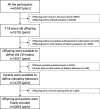Association between parental unhealthy behaviors and offspring's cardiovascular health status: Results from a cross-sectional analysis of parent-offspring pairs in China
- PMID: 36683798
- PMCID: PMC9853557
- DOI: 10.3389/fped.2022.1052063
Association between parental unhealthy behaviors and offspring's cardiovascular health status: Results from a cross-sectional analysis of parent-offspring pairs in China
Abstract
Background: Cardiovascular health (CVH) in children and adolescents, which might be largely influenced by parental behaviors, may affect the incidence of cardiovascular diseases in adulthood. However, few studies have been conducted to explore the associations between parental behaviors and CVH status of offspring in China.
Methods: Data were obtained from a cross-sectional survey conducted in Chinese children and adolescents aged 7-18 years old, with a total of 10,043 parent-offspring pairs included. Parental behaviors included moderate to vigorous physical activity (MVPA), dietary behaviors, and weight status. The CVH status of offspring was consulted by The American Heart Association, including seven factors. The associations between parental behaviors and CVH status of offspring were evaluated by multilevel logistic regression. Stratified analyses were conducted to explore the potential modifying influence of sociodemographic factors.
Results: Most of the offspring had five ideal CVH factors; only 21.04% had six to seven ideal CVH factors. Parental unhealthy behaviors were associated with high odds of nonideal CVH status of offspring. Parental overweight/obesity, insufficient MVPA, and unhealthy dietary behaviors could increase the odds of owning one to three ideal CVH factors in offspring, with corresponding odds ratios (ORs) (95% confidence interval) of 1.61 (1.32-1.96), 1.31 (1.10-1.56), and 2.05 (1.43-2.94), respectively. There was a dose-response relationship between parental single unhealthy behavior and the odds of nonideal CVH status in offspring (P-trend < 0.001). Offspring with overweight parents had ORs of 1.25 for nonideal CVH status, compared to offspring with normal-weight parents. Among offspring who had the same number of ideal CVH factors, the cumulative association between unhealthy behaviors of parents and offspring's nonideal CVH status increased if parents had more unhealthy behaviors (P-trend < 0.001).
Conclusions: Parental overweight/obesity, insufficient MVPA, and unhealthy dietary behaviors were strongly associated with CVH status in offspring. With a cumulative association, more unhealthy parental behaviors were associated with higher odds of offspring's nonideal CVH status, suggesting that targeting parental behaviors might facilitate attainment of improving CVH status of children and adolescents.
Keywords: cardiovascular health; cross-sectional study; lifestyle; offspring; parents.
© 2023 Ma, Liu, Wu, Cui, Chen, Ma, Wang, Gao, Li, Chen, Ma, Zhang, Dong, Xing and Ma.
Conflict of interest statement
The authors declare that the research was conducted in the absence of any commercial or financial relationships that could be construed as a potential conflict of interest.
Figures




Similar articles
-
Parent-Offspring Associations of Ideal Cardiovascular Health Metrics: Findings From the 2014 to 2021 Korea National Health and Nutrition Examination Survey.J Am Heart Assoc. 2024 Jan 16;13(2):e030995. doi: 10.1161/JAHA.123.030995. Epub 2024 Jan 12. J Am Heart Assoc. 2024. PMID: 38214252 Free PMC article.
-
Parental cardiovascular health predicts time to onset of cardiovascular disease in offspring.Eur J Prev Cardiol. 2022 May 6;29(6):883-891. doi: 10.1093/eurjpc/zwaa072. Eur J Prev Cardiol. 2022. PMID: 33624039
-
Influence of Parental and Offspring Dietary Behaviors on the Association of Overweight and Obesity between Two Generations: Results from a Cross-Sectional Analysis of Parent-Offspring Trios in China.Nutrients. 2022 Nov 2;14(21):4625. doi: 10.3390/nu14214625. Nutrients. 2022. PMID: 36364886 Free PMC article.
-
Post-traumatic Stress Disorder in Prisoners' Offspring: A Systematic Review and Meta-analysis.Clin Pract Epidemiol Ment Health. 2020 Apr 1;16:36-45. doi: 10.2174/1745017902016010036. eCollection 2020. Clin Pract Epidemiol Ment Health. 2020. PMID: 32508968 Free PMC article. Review.
-
Parental Misperceptions of Their Offspring's Weight and Their Strategies for Child's Eating Behavior: A Narrative Review of the Recent Evidence.Children (Basel). 2022 Oct 16;9(10):1565. doi: 10.3390/children9101565. Children (Basel). 2022. PMID: 36291501 Free PMC article. Review.
References
-
- WHO. Cardiovascular diseases (CVDs), 11 June 2021. Available from: https://www.who.int/zh/news-room/fact-sheets/detail/cardiovascular-disea...) (accessed January 3, 2022)
-
- Lloyd-Jones DM, Hong Y, Labarthe D, Mozaffarian D, Appel LJ, Van Horn L, et al. Defining and setting national goals for cardiovascular health promotion and disease reduction: the American Heart Association's Strategic Impact Goal through 2020 and beyond. Circulation. (2010) 121(4):586–613. 10.1161/CIRCULATIONAHA.109.192703 - DOI - PubMed
-
- Nguyen ATH, Saeed A, Bambs CE, Swanson J, Emechebe N, Mansuri F, et al. Usefulness of the American Heart Association’s ideal cardiovascular health measure to predict long-term major adverse cardiovascular events (from the heart SCORE study). Am J Cardiol. (2021) 138:20–5. 10.1016/j.amjcard.2020.10.019 - DOI - PubMed
LinkOut - more resources
Full Text Sources

